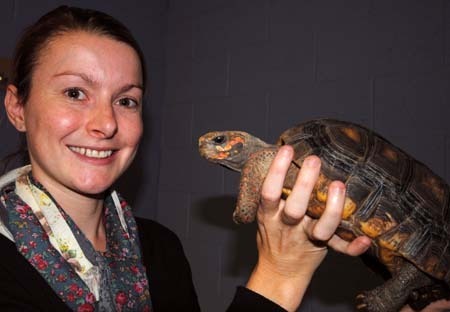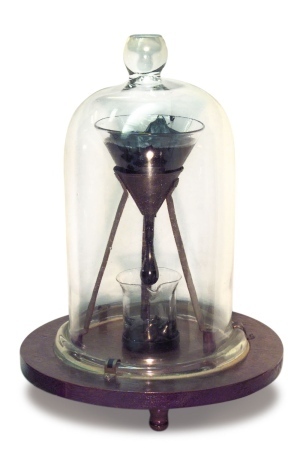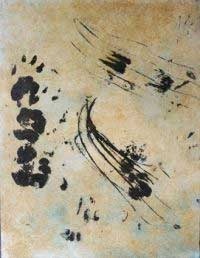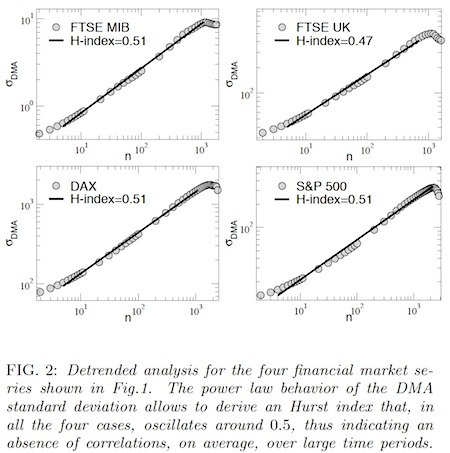Marc Abrahams's Blog, page 506
March 21, 2013
Nottingham Ig Nobel show Thursday night!
Nottingham Trent University is hosting a big Ig Nobel show Thursday night (21 March), featuring Marc Abrahams and four Ig Nobel Prize winners: Anna Wilkinson (on the absence of contagious yawning in tortoises), Charles Deeming (courtship behaviour of ostriches towards humans under farming conditions in Britain), Robin Ball (the physics of human ponytails), and Bob Batty (herrings apparently communicate by farting).
 It’s in the Newton Building, on the university’s City site, beginning at 6:45 pm.
It’s in the Newton Building, on the university’s City site, beginning at 6:45 pm.
The event is FREE, but (as they say in Nottingham), “booking is essential”. Here’s how to book reservations.
This is a featured event in the 2013 Ig Nobel Tour of the UK. Here is a photo of Ig Nobellian Anna Wilkinson and her tortoise. In this photo, neither is yawning:


Nature looks, briefly, at the long-running pitch drop experiment
Nature takes a quick look at the now-86-year-long pitch drop experiment, and at several other long-running experiments. The people who started and tend the pitch drop experiment were awarded the 2005 Ig Nobel Prize in physics. Nature says, in part:
The pitch-drop experiment started when Thomas Parnell, the university’s first professor of physics, set up a demonstration for his students to show that a sample of pitch, a black tar distillate that is brittle enough to shatter with a hammer when cold, will act like a liquid and flow through a funnel, dripping out of the bottom like the world’s slowest hour glass. It did, at a rate of about one drop every 6–12 years. Mainstone expects — cautiously — the ninth drop to fall sometime towards the end of this year.
The experiment is not exactly a hotbed of discovery. In 86 years, it has yielded exactly one scientific paper, which calculated that the pitch was 230 billion times more viscous than water….


March 20, 2013
Shaving cream in low pressure (video)
This video (of a dab of shaving cream under glass, as someone lowers the air pressure) comes courtesy of the Wake Forest physics department:

Acoustical fears force cancellation of heavy metal concert at museum
Fear that the sonic effects of live heavy metal music* would destroy exhibits and perhaps part of the building led the Victoria and Albert Museum, in London, to cancel a scheduled performance by the musical group Napalm Death. The concert was scheduled to happen this Friday night, but now is not.
Details are in The Times, in a report headlined “Heavy metal brings house down at V&A“.
* in concert with the acoustico-mechanical effects of those effects
BONUS: Video of Napalm Death performing their ode to scum. The song is entitled “Scum”:

Nottingham Ig Nobel show Thursday night!
Nottingham Trent University is hosting a big Ig Nobel show Thursday night (21 March), featuring Marc Abrahams and four Ig Nobel Prize winners: Anna Wilkinson (on the absence of contagious yawning in tortoises), Charles Deeming (courtship behaviour of ostriches towards humans under farming conditions in Britain), Robin Ball (the physics of human ponytails), and Bob Batty (herrings apparently communicate by farting).
 It’s in the Newton Building, on the university’s City site, beginning at 6:45 pm.
It’s in the Newton Building, on the university’s City site, beginning at 6:45 pm.
The event is FREE, but (as they say in Nottingham), “booking is essential”. Here’s how to book reservations.
This is a featured event in the 2013 Ig Nobel Tour of the UK. Here is a photo of Ig Nobellian Anna Wilkinson and her tortoise. In this photo, neither is yawning:


March 19, 2013
Progress in academic maggot painting (part 3 of 3)
 Following our recent items on academic maggot painting in the US and UK, (beginning with part 1, and proceeding thence to later parts) we now switch attention to Tasmania, Australia, and the artworks created by Dr. John Parish Ph.D. who entitled his 2012 thesis for the University of Tasmania : ‘Lost or Gone. Nature’s remnants: mysteries and threats of human and native species interactions, past and present.’
Following our recent items on academic maggot painting in the US and UK, (beginning with part 1, and proceeding thence to later parts) we now switch attention to Tasmania, Australia, and the artworks created by Dr. John Parish Ph.D. who entitled his 2012 thesis for the University of Tasmania : ‘Lost or Gone. Nature’s remnants: mysteries and threats of human and native species interactions, past and present.’
Part of the project examined the way in which maggots might be able to assist in the process of creating artworks. A university news-release expands on Dr. Parish’s methodology :
“He placed the carcasses of a [Tasmanian] devil, a wallaby, a possum and a quoll each in its own Parish-created contraption allowing the maggots to drop into a funnel, then into one of four dishes containing four different coloured paints.
The maggots swam out of the paint, crawling across the paper away from the light, leaving behind their individual records. Mysteriously, these maggot patterns somehow ‘embody some aspect of the creatures consumed,’ John maintains.
Placed beside his intricate drawings of the animals, the maggot markings bear an uncanny resemblance to the animal they dropped out of: heavy black splodges for the devil; light swirly patterning for Tasmania’s native cat, the quoll.”
This concludes a short Improbable series on academic maggot painting.

Ugly and Pretty Paintings, and Laser Beams, and Swearing
Prior to 2008 no one knew, at all precisely, the pain people suffer when they gaze at an ugly painting – relative to what they’d feel if they were looking at a pretty picture – while a stranger shoots them in the back of the hand with a powerful laser beam. Now something is known about the subject. The knowledge is preserved in a study called Aesthetic Value of Paintings Affects Pain Thresholds.
The study’s authors, Marina de Tommaso, Michele Sardaro and Paolo Livrea at the University of Bari in Italy, had 12 people each identify paintings as beautiful or ugly, then stare at some of each kind while a laser heated into the dorsal surface of their hand. Each volunteer, after each viewing, rated the pain on a scale of zero to 100. The hurt was a little worse when they looked at ugly art, they said, mostly.
This manner of inflicting pain – applying a carefully aimed column of light amplified by stimulated emission of radiation (that’s the phrase, more or less, that gives us the cool, five-letter word “laser”), is not the only possible way….
—So begins this month’s Improbable Research column in The Guardian.

Engineering analyses of Noah’s ark
Noah’s ark, if it existed, was an impressive piece of engineering. Here’s one detailed analysis of just how impressive:
“The Impossible Voyage of Noah’s Ark,” Robert A. Moore, Creation/Evolution Journa , issue 11 (Winter 1983)
Moore goes into considerable detail. He also laments the loss to humanity of the engineering expertise that must have gone into designing and building the vessel:
Noah’s primary contribution to humanity, his incredible knowledge of naval engineering, vanished without a trace, and the seafarers returned to their hollow logs and reed rafts. Like a passing mirage, the ark was here one day and gone the next, leaving not a ripple in the long saga of shipbuilding.
Years later, Glenn Moran reviewed a book called Noah’s Ark: A Feasibility Study, by John Woodmorappe [El Cajon: Inst. for Creation Research,1996, 298 pp.] Moran writes:
Judging by the number of citations, this book is far and away a reaction to R.A. Moore’s 1983 article “The Impossible Voyage of Noah’s Ark,” Creation/Evolution 11:1-43. At every turn Moore’s name and ideas are being countered or attacked.
Towards the end of the review, Moran writes:
To my suggestion that the carnivores when released, would start eating the few survivors of the Flood, Woodmorappe suggests that large numbers of carcasses which had been buried early in the flood were re-excavated and used as food for the carnivores.
(Thanks to investigator Lauren Maurer for bringing this to our attention.)
BONUS: Johan’s ark, in The Netherlands, as described by The Daily Mail. (Thanks to Kurt Verkest for bringing this to our attention.)

Long-term results: Should You Trade Stocks Randomly?
The Ig Nobel Prize-winning Italian researchers who demonstrated the benefits, for organizations, of promoting people at random have turned their analytical weapons on a new target. Their new study examines what happens over the long term if one randomly, rather than systematically, chooses stocks:
“Are random trading strategies more successful than technical ones?” A.E. Biondo, A. Pluchino, A. Rapisarda, D. Helbing, arXiv:1303.4351, March 18 2013. The authors explain:
“we study the performance of some of the most used trading strategies in predicting the dynamics of financial markets for different international stock exchange indexes, with the goal of comparing them with the performance of a completely random strategy. In this respect, historical data for FTSE-UK, FTSE-MIB, DAX, and S&P500 indexes are taken into account for a period of about 15-20 years (since their creation until today)….
“Our main result, which is independent of the market considered, is that standard trading strategies and their algorithms, based on the past history of the time series, although have occasionally the chance to be successful inside small temporal windows, on a large temporal scale, perform on average not better than the purely random strategy, which, on the other hand, is also much less volatile. In this respect, for the individual trader, a purely random strategy represents a costless alternative to expensive professional financial consulting, being at the same time also much less risky, if compared to the other trading strategies.”
The study includes this chart:

HISTORY: The 2010 Ig Nobel Prize in management was awarded to Alessandro Pluchino, Andrea Rapisarda, and Cesare Garofalo of the University of Catania, Italy, for demonstrating mathematically that organizations would become more efficient if they promoted people at random. REFERENCE: “The Peter Principle Revisited: A Computational Study,” Alessandro Pluchino, Andrea Rapisarda, and Cesare Garofalo, Physica A, vol. 389, no. 3, February 2010, pp. 467-72.]

If you build it, they will come and wonder at it
The You Had One Job blog documents curious design and/or construction results. This photo, showing a stairway with contrasting handrail, is one of the many treasures to be found there:
 (Thanks to investigator Vaughn Tan for bringing this to our attention.)
(Thanks to investigator Vaughn Tan for bringing this to our attention.)

Marc Abrahams's Blog
- Marc Abrahams's profile
- 14 followers



